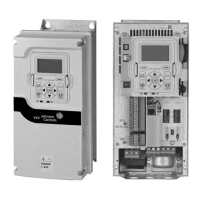92 VARIABLE SPEED DRIVE SERIES III LIT-12012999—June 2018 www.johnsoncontrols.com
Chapter 7—Advanced application parameter
Chapter 7—Advanced application parameter
The Advanced Application is designed for a large subset
of applications in the HVAC industry. It includes some
advanced timer and logic control to operate in addition to
the Basic and PID applications functions listed earlier. It is
designed to make use of the standard HOA control along
with the control operations that would be used in advanced
setups. Below is a list of features that is available.
Advanced Application includes functions:
•
Bypass Control
•
Fire Mode
•
Damper Control
•
Pre heat/cold weather mode
•
Hand/Off/Auto in individual button for easy change of
control mode.
•
Damper Control
•
Programmable Protections
•
Programmable digital/analog input/output function
•
Programmable start/stop signal logic
•
Voltage and Current limiters
•
Energy Savings Calculator
•
Two independent set of Acceleration/Deceleration ramps
•
Skip frequency
•
Start source (Local/Remote control function)
•
Reference source
•
Flying start
•
Volts per Hertz control programmable
•
Real time clock—RTC time display
•
RTC Timers and Interval control
•
Auto restart on fault to drive or bypass
•
Programmable switching frequency
•
Multi-Preset speeds
•
Fan control
•
Joystick Control
•
Logic Functions
•
Bumpless transition between Hand and Auto
•
Drooping
I/O Controls
•
Terminal To Function (TTF) Programming
The design behind the programming of the digital
inputsinthe VS3 drive is to use “Terminal To Function”
programming, which is composed of multiple functions
that get assigned a digital input to that function. The
parameters in the drive are set up with specific functions
and by defining the digital input and slot in some cases,
depending on which options are available. For use of the
drives control board inputs, they will be referred to as
DigIN:1 through DigIN:8. When additional option cards
are used, they will be defined as DigIN:X:IOY:Z. The X
indicates the slot that the card is being installed in, which
will be either A or B. The IOY determines the type of card
it is, which would be IO1 or IO5. The Z indicates which
input is being used on that available option card.
•
Function To Terminal (FTT) Programming
The design behind the programming of the relay
outputsanddigital output in the VS3 drive is to use
“Function To Terminal” programming. It is composed of
a terminal, be it a relay output or a digital output, that
is assigned a parameter. Within that parameter, it has
different functions that can be set. The parameters of the
Standard Application are explained in Appendix A of this
manual, “Description of Parameters.” The explanations
are arranged according to the parameter number. For
the DI function, we use Terminal programming method
to function (TTF), where there is a fixed input that gets
programmed to a list of functions. This allows for multiple
inputs to be used for different functions. Connecting a
certain input with a certain parameter function is done
by give a parameter an appropriate value. The value is
formed by the location of the input, either being on the
standard control board or an external option board and
the slot it is located in.

